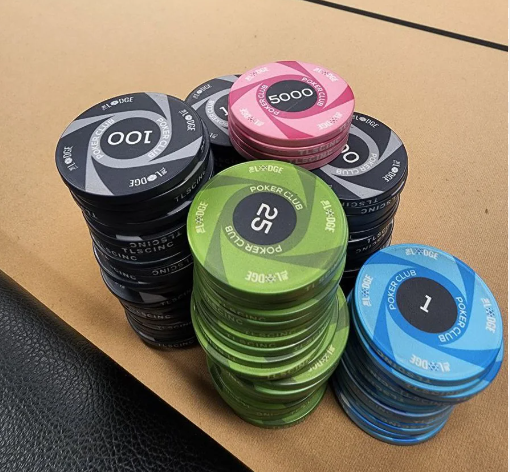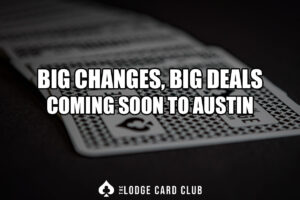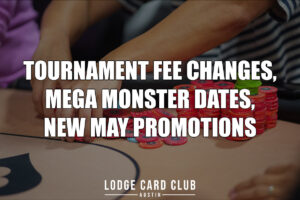Check out the cash game listings at the Lodge, and you’ll see games running across a variety of different stakes. For each stake level, you’ll see a range for the buy-in amount allowed in that game.
You can break down the stakes for each of those poker games in terms of big blinds.
The $1/2 No-Limit Hold’em game at the Lodge, for instance, features a $1 small blind and a $2 big blind. You can buy-in for anywhere between $100 and $300 big blinds in that game.
That poses the question – how many big blinds should you have when you buy into a cash game? Let’s discuss that topic in this guide from the Lodge Poker Club.
Cash Game Buy-ins In Terms Of Big Blinds
Consider the buy-in range for the Lodge $1/$2 No-Limit Texas Hold’em game.
To play in that game, you must sit down at the table with at least $100 in chips. The maximum buy-in is $300. You can choose any amount within that range when you take a seat in the $1/$2 game.
What amount you should you choose in terms of the number of big blinds? Many poker strategy articles say you shouldn’t sit in on a poker cash game with anything less than 100 big blinds. In this case, that’s $200.
There really isn’t a right or wrong approach to how many big blinds to buy in for in a cash game, however. Consider these insights from Upswing Poker Vice President and Lodge Head of Marketing Mike Brady:
“There are three valid approaches when it comes to buying into a cash game,” Brady says. “You can buy-in for the table maximum to ensure you get to play as deep stacked as possible. All else equal, this is the best option for strong players who have an edge in the games.”
For the $1/$2 NLH game at the Lodge, $300 is a great option if you’re an experienced player, and think you have an edge in the game. The $300 buy-in equates to 150 big blinds, which is a fairly deep stack in a cash game.
While buying in for the max is a great way to play if you’re a skilled player, buying in for the minimum and entering the game as a short stack is also a viable option, especially for poker beginners.
“You can also buy in for the minimum to reduce your risk,” Brady says. “This is usually the best option for less experienced players who are learning the game. Mistakes cost a lot less money when you’re short-stacked!”
The $1/$2 NLH game at the Lodge offers the option to start with any stack size between $100 and $300. You don’t have to buy in for the minimum or the maximum.
“The last option is to simply buy in for whatever you’re most comfortable with,” Brady says. “For example, suppose you sit at a table with a $300 max, but you’re more comfortable risking $200 at a time instead.”
“It’s completely reasonable to buy in for that $200. In the end, you should do what makes the most sense given your experience, bankroll, and risk tolerance. There are really no wrong answers.”
To Brady’s last point; most cash games in online poker rooms feature a max buy-in of 100 big blinds. You’ll find that many live poker cash games mirror online games, also offering a max buy-in of 100 big blinds.
Keep in mind that 100 big blinds is a pretty standard buy-in for all cash games, no matter what the blind levels. Manysolid poker players buy in for 100 big blinds, no matter what the maximum buy-in.

Does Your Buy-In Amount Change Your Strategy in a Poker Cash Game?
Whether you like to buy into a cash game for the minimum, the maximum, or somewhere in between, you can become a good player with a solid win rate in live games.
Optimal strategies for cash games do shift depending on the size of the effective stack in a hand. The effective stack in a hand represents the amount of money on the line if two players go all-in.
For example, if you go all in for $300, and an opponent calls with a $200 stack, the effective stack is $200.
Let’s look at a few notes on strategy for various effective stack sizes (in terms of big blinds).
Short Stack Cash Game Strategy (50 or Less Big Blinds)
Short stackers (players with less than 100 big blinds) can be found in just about every poker cash game.
If you find yourself sitting with a short starting stack, or are in a hand where the effective stack is short, it’s important to keep a few adjustments in mind:
Optimal Short Stack Preflop Ranges Are Different
Low pocket pairs and middling suited connectors don’t play as well when the effective stack is short. These types of hands play much better when the stacks are bigger, and you have a chance of winning a huge pot when they improve.
For example, let’s say you’re in the Lodge $1/$2 game and you have $100. You’re in the cutoff with pocket threes, and an early-position player has open raised to $10.
Calling isn’t ideal as a short stack in this spot. Pocket threes play much better when you’re deeper stacked, and can win a massive pot when you hit a set. When you don’t have the ability to win a big pot, the pot odds for calling just aren’t there for you to flat with a hand like pocket threes.
The Threshold For Going All-In is Lower When Short-Stacked
Whether it’s preflop or postflop, the threshold for going all-in is lower for a short-stacked player when compared to a bigger stack.
Let’s go back to the above example, where you have a $100 stack in the cutoff. An early-position player open raises to $10, and you have AQ.
Going all in over the top of the open raise might be better than just calling with a 50-big-blind stack. With a big stack (say $200 or more) you wouldn’t really ever shove over the top of a standard open raise preflop size like $10 (5x the big blind).
With a shorter stack, however, you’re incentivized to just get the money in the middle with a strong hand like AQ.
Let’s say you decide to just flat call with AQ in this spot. If an ace-high flop comes, you should look to get all-in however possible.
A Note On Poker Tournaments and Short Stacks
If you plan on playing tournaments, get used to playing with a short chip stack.
In most tournaments, the stacks are above 100 big blinds for only the first few levels. You might occasionally make a run where you have a big stack in the later stages of a tournament, but for the most part most of the players at the poker table throughout a tournament will have less than 100 big blinds, and often less than 50 big blinds.
Deep Stack Cash Game Strategy (150 or More Big Blinds)
Many professional poker players prefer to buy to a cash game for at least 150 big blinds. Deep stack poker allows you more playability both preflop and postflop, and also allows you to win more money if you stack an opponent.
If both you and another player’s stack is $300 in the Lodge $1/$2 game, you can win $300 if you and the opponent go all-in and you win. If you have $100 (or you get all-in against an opponent that has $100), the most you can win in that hand is $100.
Playing deeper-stacked allows you to play a wider range of hands preflop. You can use your skill level to your advantage postflop, as you’ll have more maneuverability with your value bets and bluffs.
With a bigger stack, you can call more often preflop with small pocket pairs and middling suited connectors. The implied odds of winning a big pot justify calling with these types of hands.
The Threshold For Going All-In is Higher When Deep-Stacked
Let’s say you have $200, and look down at pocket aces in the cutoff. An early-position player opens to $10, you 3-bet to $40, and your opponent calls.
The flop comes 9-8-7. Your opponent checks, you bet $40 (into the $80 pot), and your opponent goes all in for $120. In this spot, you should call with your pocket aces, as you already have $80 invested in the pot, and it’s only $80 more to call with the potential to win a $400 pot.
Let’s suppose in that same spot, both you and your opponent start with $600. The hand unfolds the same way, but your opponent shoves for $520 over your $40 flop c-bet.
With much more money at risk, your pocket aces might not be good enough to call in this spot. If your opponent understands deep stack dynamics, then they probably have a very strong hand in this spot.
Cash Game Buy-In Ranges at the Lodge
Different cardrooms offer different ranges of buy-ins for different cash game stakes.
The cash games at the Lodge feature some of the deeper buy-in ranges that you’ll see at any poker room.
Here’s a look at the stakes and buy-ins for the cash games at the Lodge:
The Lodge No-Limit Hold’em Cash Games
$1/$2 No-Limit Hold’em: $100-$300 Buy-in
$1/$3 No-Limit Hold’em: $200-$1,000 Buy-in
$2/$5 No-Limit Hold’em: $200-$2,000 Buy-in
$5/$10 No-Limit Hold’em: $500-$3,000 Buy-in
$5/$10/$25 No-Limit Hold’em: $1,000-No Max Buy-in
The Lodge Omaha Cash Games
$2/$2 Pot-Limit Hold’em: $200-$700 Buy-in
$1/$2/$5 Pot-Limit Omaha: $200-$1,000 Buy-in (Match The Stack)
$1/$2/$5 Big-O: $200-$1,000 Buy-in (Match The Stack)
$5/$10/$25 PLO/Big-O: $1,000-No Max Buy-in
For more on cash games in general, check out this guide from the Lodge blog:



